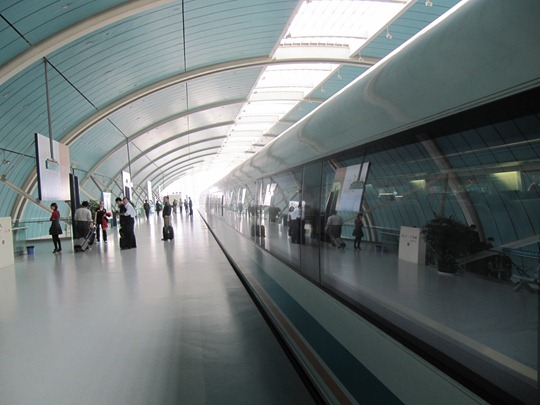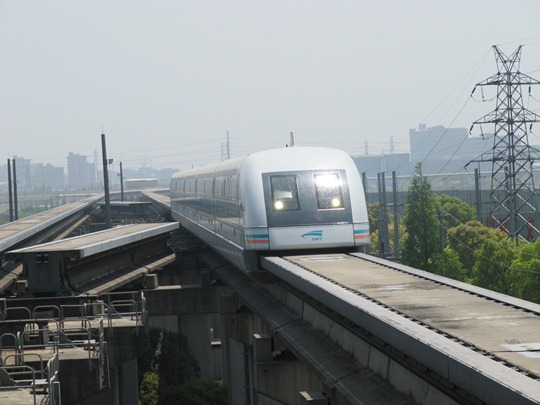Photos and video by James D. Schwartz / The Urban Country
Imagine you could build a train that could take you 100KM in less than 15 minutes. Where would you put this train? From your home to you workplace? To your Grandma’s house?
I had the pleasure of riding the Shanghai Maglev high speed train earlier this month when I first arrived in China. I am fascinated by this train and the opportunities it presents for the future of transporting people.
Following is a video of my experience on the Shanghai Maglev train to give you an idea of how it feels to progress to 430 km/h and cover a distance of 30 kilometres in only 7 minutes:
This train uses magnetic levitation to prevent the train from having physical contact with the track – thus eliminating rolling resistance to improve efficiency in the amount of energy required to run the train.
Our train systems in North America are far behind the rest of the world. Most of our trains run on dirty diesel and few train routes are actually faster than driving, so it’s no wonder most people still primarily use automobiles as their primary means of transportation.
Commuters in the suburbs of Toronto typically take commuter trains to work not necessarily because it’s faster, but because it is less stressful (and more reliable) than dealing with rush hour traffic and parking downtown.
Our commuter train lines are constantly being pushed further and further from downtown Toronto to provide commuting opportunities for people who live further and further away from the city. All this does is encourages more sprawl. As soon as a new line goes up, large housing communities are built with no forethought about sustainability.
Instead of encouraging people to live further and further away from the city where they work and building unnecessarily large houses, we should improve our existing transit systems to encourage people to use a cleaner method of transportation than single occupancy vehicles to commute to work.
Building a high speed electric train coupled with a bike sharing program or public transit downtown would go a long way for encouraging commuters to give up their automobile for commuting to work.
These types of trains could also be used to connect cities and reduce the number of short-haul high-emission flights and diesel burning bus rides between cities.
Having said that, the Shanghai maglev train is over the top. It cost 9.93 billion RMB to build and at 7000 passengers per day and 50RMB per passenger, it would take 77 years just to pay back the capital costs (this doesn’t even include the operating costs). In other words, this baby isn’t cheap.
Perhaps a more fiscally realistic high-speed train is the electric train being built on Hainan island to connect Haikou City in the north and Sanya in the south.
This train will operate at about 200KM/h on a traditional railway track and it is estimated that it will take about 90 minutes to travel from Haikou to Sanya across a distance of 308KM. Much of the track is elevated like the Shanghai Maglev train, and the cost to build the entire line is said to be $19.22 billion RMB ($~2.8 billion USD).
Last week I traveled to Sanya from Haikou by bus and it took 3.5 to 4 hours on a diesel-powered coach bus. An electric train has the opportunity to reduce the emissions and greatly reduces the time it takes to travel between these two cities.
If we had electric trains in North America that provided a distinct advantage over driving an automobile, then perhaps we could reach a tipping point and start reducing our reliance on automobiles.
James D. Schwartz is the editor of The Urban Country. You can contact James at james.schwartz@theurbancountry.com.
Stay tuned – more articles from my 3-week trip to China are on the way.
Related Articles:




You say the maglev train will need 77 years to pay back its capital cost, but if the 200KM/h electric train will cost $19.22 billion RMB ($~2.8 billion USD) how long will it take to pay off its capital cost?
That’s a great question Mr. Blow. It would of course depend on the average number of daily passengers and the price per passenger. Unfortunately this information is not yet available.
Given your specialization in this industry, you would probably be more qualified than me to estimate this, but I’ll take a first crack at it anyway.
First I will point out that the Haikou-Sanya train is 10 times the distance of the Shanghai maglev train (308KM vs. 30KM), but the cost to build it is only double.
Charging 10 times the price for a ticket wouldn’t be reasonable – given what I know about traveling from Haikou to Sanya.
So I will speculate that the cost to take this train 308KM will be approximately 200RMB per passenger (the Shanghai maglev is 50RMB).
Now the tricky part is guessing how many passengers will be served each day. Let’s pretend that the Haikou-Sanya train will service the same number of passengers as the Shanghai maglev train (7,000 people). If this is the case, it would take 37 years to pay back the capital costs – assuming the train operates 365 days per year.
My gut is telling me that 7,000 is probably higher than what it would be in reality (though this number would presumably grow every year as the tourism industry in Hainan grows).
I think a more realistic number would be 3,500 passengers per day. That’s 10 trains a day with an average of 350 people on each train. That would mean it would take 75 years to pay back the capital costs.
That’s still a really long time. But government subsidization of public transit isn’t anything new. I don’t know of any public transit system in the world that pays for its operating costs and capital costs through passenger fees.
Here in Toronto, passenger fares pay for about 70% of the operating costs (which I’ve heard is much higher than most public transit systems), but the billions of dollars in capital costs are investments made by the multiple levels of government and could never be paid back through user fees.
It’s a seriously impressive train. But the consequences of it are terrible. It will inevitably use an awful lot of energy to move people at that speed. In fact, it’s quite possible that a train at over 400 km/h is less efficient than private cars.
Even if it is not, the other problem with such facilities is that they make longer distance travel possible, even convenient. If you can do a 200 km commute in half an hour then people will do 200 km commutes.
Of course, 30 minutes isn’t so much. Many people have commutes which take over an hour at the moment.
Just wait and see. Haikou to Sanya is going to be many people’s 600 km per day commuting route.
What level of efficiency would be required to make this even vaguely comparable to hopping on a local bus or cycling a few km to get to work ?
David, I agree that the air resistance at 400+ km/h would be very high, which is why I think the 430km/h train is a bit over the top. I’m still not sure if it would compare to an automobile, but I can’t confirm one way or another.
I also agree that if people in North America had high speed trains, it might encourage them to live even further from their workplace.
But in China, I don’t see it as something that encourages sprawl. From what I have seen, Chinese people aren’t interested in commuting for several hours a day (like people do in North America). I’ve never even seen a detached house in China – everyone lives in apartments/condos/attached townhomes. This is all despite the fact that there is vast land available in China outside of cities.
The Chinese seem to enjoy their high density communities and living relatively close to their workplace.
You could argue that this will change as automobile ownership rises, but I still don’t think Chinese people envy the sprawl and long commute times that result in sprawl and low density housing developments.
James. I’ve always loved excellent transportation. However this is simply impractical in Ontario. Freak storms like the ones we have, would shut this down. Otherwise, the introduction of this down the Quebec-Windsor Corridor would be just fantastic, and turn everything within a 1-hour commute (400 km?) of Toronto, into bedroom communities. Instantly, that would change Southern Ontario like we’ve never seen it before.
West: Windsor
East: Cornwall (that would easily cover Ottawa as a bedroom community, giving competition to Porter Air)
North (if it went North): Well North of Parry Sound
Essentially that is all of Southern Ontario.
Budgets aside, of course. And the need for regional support. Surface transport, even reaching into cities, could be the regional system, I am thinking.
Dang. Why are we so behind?
James. I’ve always loved excellent transportation. However this is simply impractical in Ontario. Freak storms like the ones we have, would shut this down. Otherwise, the introduction of this down the Quebec-Windsor Corridor would be just fantastic, and turn everything within a 1-hour commute (400 km?) of Toronto, into bedroom communities. Instantly, that would change Southern Ontario like we’ve never seen it before.
West: Windsor
East: Cornwall
North (if it went North): Well North of Parry Sound
Essentially that is all of Southern Ontario.
Budgets aside, of course. And the need for regional support. Surface transport, even reaching into cities, could be the regional system, I am thinking.
Dang. Why are we so behind?
Pingback: Bicycles for Transporting… [fill in the blank] ← The Urban Country